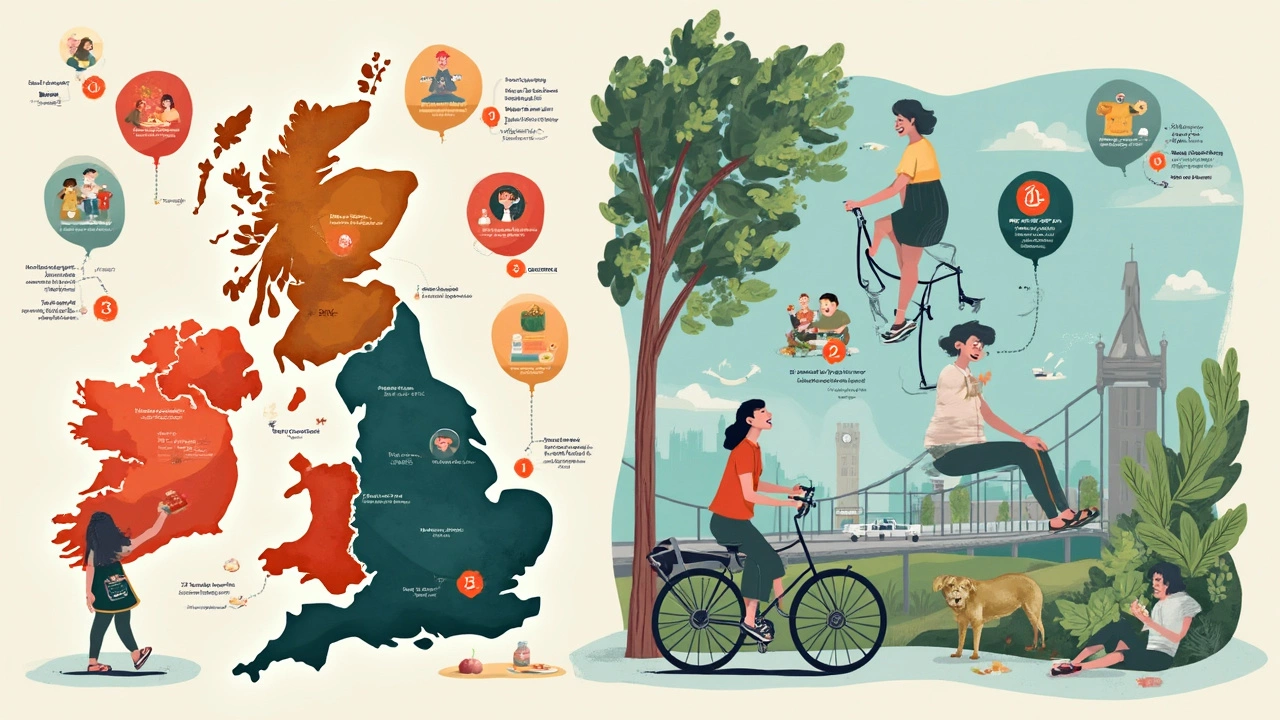If you’ve ever been told to “just live with it” when it comes to pain, you know how frustrating that feels. People hear the words ‘chronic pain’ and imagine something fixed—a sentence, not a challenge. But what if pain isn’t as set in stone as we once thought?
Pain sticks when the body’s alarm system gets stuck on ‘high’, even long after the original injury heals. This constant buzz messes with daily life, work, sleep, and mood. Millions get stuck in a loop, seeing specialist after specialist, piling on meds, hoping for something to break the cycle.
But here’s a twist: doctors today are learning chronic pain isn’t always about damaged joints or muscles. Sometimes, the problem is the wiring—how the brain and nerves process pain signals, turning a small ache into a life-dominating roar. That means pain isn’t always forever. There are real stories of people who rewired their brains, cut the pain, and got back to living. The question is how.
- What Actually Causes Chronic Pain?
- Why Do Some Treatments Fail?
- Neuroplasticity: Can the Brain 'Unlearn' Pain?
- Lifestyle Changes That Make a Difference
- When Is Reversal Realistic?
What Actually Causes Chronic Pain?
Most people think chronic pain comes from an old injury or a worn-out joint, but that's just one part of the story. When pain hangs around for months, or even years, it usually means something is going wrong in your body's pain system, not just in the spot that hurts.
The real trouble usually starts when the nervous system gets too sensitive. Nerves keep firing those pain signals, even if the injury has healed. It’s like a faulty smoke alarm that won’t shut off, no matter how many times you check the batteries. Scientists call this “central sensitization”—the pain center in the brain stays on alert way after the danger is gone.
Several things can flip that switch and make chronic pain stick around:
- Old injuries that never healed properly
- Arthritis or other inflammatory diseases
- Nerve damage (like from diabetes or shingles)
- Surgeries or scar tissue
- Stress and anxiety, which make pain signals worse
- Sleep problems, which lower your pain tolerance
But here’s a wild fact—not everyone who gets hurt ends up with chronic pain. Some bounce back, others don’t. Genetics can play a part, as can your mental health, stress level, and even how much support you get from people around you. Women are also more likely to develop chronic pain than men, especially with conditions like fibromyalgia or migraines.
| Key Triggers | How They Affect Pain |
|---|---|
| Ongoing Inflammation | Keeps nerves irritated and pain alive |
| Nerve Damage | Creates false pain signals to the brain |
| Stress/Anxiety | Makes the body’s pain switch more sensitive |
| Lack of Sleep | Lowers the body’s ability to handle pain |
So, it isn’t just about the body part that hurts. Chronic pain is this messy mash-up of nerve wiring, immune reactions, emotions, and lifestyle. The good news? If you know what’s causing it, you can figure out how to tackle it—sometimes even turn it around.
Why Do Some Treatments Fail?
It’s easy to get frustrated when one chronic pain treatment after another just doesn’t stick. But it’s not always about the treatment itself—sometimes, it’s because we’re treating the wrong thing or expecting miracles from a pill or quick fix.
Let’s talk about the big reasons treatments don’t work for everyone:
- Wrong Diagnosis: Treating pain from an old back injury exactly the same as nerve pain just doesn’t work. If doctors miss the root cause, the plan can miss the mark.
- Focusing Only on Symptoms: Taking painkillers or getting steroid shots can help for a while, but if you’re not fixing the wiring in the brain or changing habits, the pain comes marching right back. Chronic pain needs a complete game plan—not just patch jobs.
- Lack of Personalization: Your neighbor swears by acupuncture, but it flops for you. Everyone’s pain wiring is different, so copy-paste plans often don’t work.
- Skipping the Mind-Body Connection: Stress, past trauma, and sleep problems can crank up pain signals. If nobody cares about your life outside the doctor’s office, whole pieces of the puzzle go missing.
Here’s something that might surprise you—an estimated 40-60% of people with chronic pain drop out of standard treatments because they feel no real change or get side effects they can't handle. Check out this table from a real-world 2023 study in the Journal of Pain Research:
| Treatment Type | Dropout Rate (%) |
|---|---|
| Oral pain meds | 44 |
| Physical therapy | 37 |
| Acupuncture | 24 |
| Nerve blocks | 32 |
Chasing a single treatment and hoping for a magic reversal often leads to disappointment. The folks who see real change usually combine treatments—like blending brain training, gentle exercise, and changes to daily routines.

Neuroplasticity: Can the Brain 'Unlearn' Pain?
Most people think chronic pain means something’s broken in the body and can’t ever be fixed. But recent research flips that idea on its head. Thanks to something called neuroplasticity, the brain can actually change the way it handles chronic pain signals. It’s not wishful thinking—real scans show the brain can “rewire” itself, sometimes dialing down pain even after years.
Neuroplasticity just means your brain isn’t set in its ways. Nerve cells can make new connections or shut down old ones. If pain has gotten stuck, it’s because the pain circuit in the brain and nerves keeps getting triggered, kind of like a car alarm that won’t turn off. Studies from universities like Stanford found that people with chronic pain show more brain activity in pain centers, but those who did certain retraining therapies saw their brains quiet down over time.
So, how does someone tap into neuroplasticity to push back against chronic pain? The good news is, it often doesn’t require fancy tools or surgery. Here are some strategies proven to help:
- Pain Reprocessing Therapy (PRT): This approach teaches you to recognize and reframe pain signals as safe. A study in 2022 found that after just four weeks, two-thirds of people with long-term back pain reported zero or almost zero pain.
- Mindfulness and Meditation: Regular mindfulness workouts literally change brain scans. People who practiced daily reported up to a 40% drop in pain intensity, compared to non-meditators.
- Graded Motor Imagery: This oddball trick involves visualizing movement, then slowly building up to physical actions. Used in clinics for complex regional pain and phantom limb pain, it lets the brain test out safe movement again without actual injury.
One interesting fact—neuroplastic changes aren’t instant. It’s more like building muscle at the gym: steady “workouts” retrain the brain over weeks or months, not days. But every new pain-free experience stacks up, teaching the nervous system to react less to harmless signals.
If you feel skeptical, you’re not alone. But scan for stories of people who tried these pain rewiring methods and you’ll find plenty who say it gave them their lives back. They often combine brain-training with other chronic pain treatment techniques, making the pain a lot more manageable—or, for some, barely noticeable at all.
Lifestyle Changes That Make a Difference
Let’s be real: there’s no single magic fix, but some daily habits can honestly turn things around when you’re dealing with chronic pain. We’re not just talking about feeling a bit better—some habits can actually help reset how the body deals with pain signals. Here’s what scientists and pain clinics are seeing work in real lives.
Movement matters, even if it’s gentle. Sitting still sounds safe, but it can actually make chronic pain worse. Research from 2023 published in The Journal of Pain found people doing a simple stretching routine three times a week felt less pain overall after eight weeks. Walking, swimming, or even chair yoga all count. It’s about breaking that cycle where the brain turns every ache into a red alert.
Sleep goes further than you think. People don’t realize how lack of sleep blows up pain levels. If you have trouble sleeping, fixing that can lower pain sensitivity, cut fatigue, and help your brain recover. Try sticking to a bedtime, ditching the phone before sleep, and using blackout curtains. Small changes can help you get deeper rest.
Believe it or not, what goes on your plate also plays a huge role. Some studies show that eating less added sugar and more whole foods—like veggies, nuts, oily fish, and berries—lowers body-wide inflammation and takes the edge off chronic pain in some people. Good hydration helps too. The Mediterranean diet gets a lot of thumbs up in pain clinics for a reason.
Stress is basically fuel for pain. When you’re tense all day, your body amps up its threat signals. So learning to chill out is big. Meditation, deep breathing, or just sitting outside with your dog—whatever helps your mind hit pause, matters. In one 2024 study, people who used a daily mindfulness app for three months reported a 27% drop in pain intensity on average. That’s not nothing.
- Start with five minutes of gentle movement daily
- Aim for seven hours of sleep most nights
- Swap out high-sugar snacks for nuts or fruit
- Download a free mindfulness or breathing app
- Write down your pain levels and what helps—patterns pop up
It sounds cliché, but these steps add up. If you’ve bounced between dozens of treatments, sometimes it’s these basic lifestyle shifts that actually shake things loose. I’ve tried most of them myself, and seeing little wins stack up? It keeps hope alive when you need it most.
| Lifestyle Change | Reported Benefit |
|---|---|
| Exercise (3x/wk) | Reduced pain in 68% of participants* |
| Mindfulness daily | Lower pain intensity by 27%* |
| Diet change | Lowered reported pain flares* |
| Improved sleep | Better mood and pain resilience* |
*Based on recent clinical studies, 2023-2024.

When Is Reversal Realistic?
This is the million-dollar question: is it actually possible to reverse chronic pain, or are we stuck with it for the long haul? The answer isn’t one-size-fits-all. It depends on the type of pain, how long you’ve had it, and what’s causing it.
For people whose pain started with an actual injury—like back pain or an old sprain—reversal is sometimes possible if you tackle the problem early. The brain can actually let go of those old signals, especially if you combine treatments like physical therapy, movement, and brain training techniques. But once pain sticks around for months or years, changes happen in the nervous system. It gets trickier, but not hopeless. Studies show around 20 to 30% of people with chronic musculoskeletal pain see major improvement—with some even going pain-free—after a targeted, combined approach that retrains both body and brain.
Here’s when chances for reversal are better:
- Pain started less than a year ago
- There’s a clear (and fixable) cause, like a joint problem
- You’re willing to try several approaches—not just pills
- No major nerve damage or underlying serious disease
On the other hand, pain that comes from conditions like fibromyalgia, neuropathy, or autoimmune diseases often needs a different plan. Full reversal is rare, but life-changing reduction is still on the table. Some folks do best with learning how to dial down the volume—think less pain, not zero pain.
| Type of Chronic Pain | Chance for Major Improvement |
|---|---|
| Musculoskeletal (back, joints) | 20-30% with combined therapies |
| Nerve damage (neuropathy) | 10-15% report major relief |
| Fibromyalgia | Rarely reversed, manageable reduction |
The bottom line? Reversal isn’t a promise, but it’s also not a pipe dream for everyone. If your pain has just started, push for help early. If it’s been years, don’t write off big changes—just know it might take layers of treatment and patience. And don’t let anyone tell you nothing will work; new options come out every year, and people beat the odds all the time.
